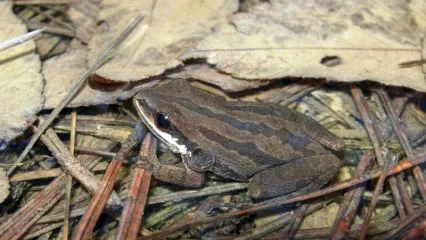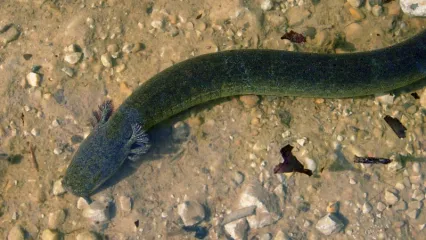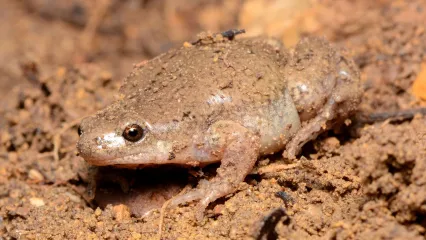
Description
These small frogs have a brown or brownish-gray background color with darker stripes of the same color on the back. Many individuals have three longitudinal stripes with irregular edges on the back, but some individuals have three rows of spots instead of stripes. Still other individuals may have a combination of spots and stripes in a longitudinal pattern. The limbs are banded with the same colors, and the skin on the body and limbs is granular. A dark brown stripe extends from the snout through the eye and onto the side of the head and body. A white or cream stripe extends from beneath the eye to below the tympanum. The belly is white to cream and may have light spotting on the chest. The black pupil is outlined above and below with a golden iris.
The tadpoles are small, brown, and have golden flecking. The upper part of the tail musculature is dark brown, in contrast to the light area below, giving the tail a striped appearance. The tail fins are transparent with fine dark brown reticluations. The throat is not pigmented and the lateral eyes are golden.
The Cajun chorus frog is one of the trilling chorus frogs (some species in the genus have a single-note call). The trill is produced at a rate of about 20 calls per minute, and each call has on average 13 pulses per second. Most chorusing occurs at night but chorusing can occur day and night early in the breeding season.
Size
Male Cajun chorus frogs reach 1.25 inches in body length. Females are slightly smaller than males.
Habitat
Cajun chorus frogs are typically found in vegetation at ground level. They occur in eastern Oklahoma and Texas, through most of Arkansas and Louisiana, and into western Mississippi.
Life Cycle
Cajun chorus frogs begin breeding in late winter or early spring depending on the latitude and weather conditions. They continue to breed for several months. Males gather in small choruses in temporary pools, including small ponds, flooded fields, roadside ditches, and swamps or marshes. Females deposit from 500 to 1,500 small eggs in clusters of 20 to 100 eggs. The egg clusters are attached to submerged vegetation, where they hatch in a few days. The tadpoles metamorphose in about two months.
How To Observe
Like other species of chorus frogs, these small frogs are difficult to observe. They can be located while calling at night along the edges of ponds or ditches where choruses have formed. Males typically call from secluded spots in grass or vegetation at the water’s edge. Finding them by day is very difficult; undoubtedly they hide in vegetation near the breeding sites.
(This profile was created by Dr. Laurie Vitt as part of a partnership between the Wildlife Department and the Sam Noble Oklahoma Museum of Natural History. It was funded as part of a larger State Wildlife Grant to survey and inventory amphibians and reptiles of the Wildlife Management Areas of Oklahoma: T-35-P-1.)

